“While medical and / or pharmaceutical-related inventions designed to treat or diagnose COVID-19 have been making news headlines, there have also been numerous software developments designed to address present day needs.”
 The United States Patent and Trademark Office (USPTO) recently announced the COVID-19 Prioritized Examination Pilot Program, under which the USPTO will advance certain patent applications related to COVID-19 “out of turn,” resulting in prioritized examination for qualifying applications. Under this program, the USPTO reportedly aims to provide final disposition of qualifying applications within one year of the filing date, meaning that a final office action or notice of allowance will be mailed (or a notice of appeal will be filed) during this shortened one year timeframe. For comparison, it typically takes the USPTO roughly 16 months from the filing of an application to mail a first office action.
The United States Patent and Trademark Office (USPTO) recently announced the COVID-19 Prioritized Examination Pilot Program, under which the USPTO will advance certain patent applications related to COVID-19 “out of turn,” resulting in prioritized examination for qualifying applications. Under this program, the USPTO reportedly aims to provide final disposition of qualifying applications within one year of the filing date, meaning that a final office action or notice of allowance will be mailed (or a notice of appeal will be filed) during this shortened one year timeframe. For comparison, it typically takes the USPTO roughly 16 months from the filing of an application to mail a first office action.
To qualify for prioritized examination under the COVID-19 Prioritized Examination Pilot Program, applicants must ensure they meet the following criteria:
- The applicant must qualify for either small or micro entity status (e.g., individuals, businesses with less than 500 employees, universities, or 501(c)(3) nonprofits).
- A qualifying application must contain one or more claims to a product or process related to COVID-19. The claimed product or process must be subject to an applicable Food and Drug Administration (FDA) approval for COVID-19 use (including, but not limited to, an Investigational New Drug (IND) application, an Investigational Device Exemption (IDE), a New Drug Application (NDA), a Biologics License Application (BLA), a Premarket Approval (PMA) or an Emergency Use Authorization (EUA)).
- The application must be either an original application or must claim priority to no more than one previous non-provisional application. Requests may be filed with the filing of a new application or with requests for continued examination (RCE) filed in existing applications.
Currently, the USPTO is only accepting 500 total requests for prioritized examination under the COVID-19 Prioritized Examination Pilot Program. As of August 13, 2020, 255 requests for prioritized examination under this pilot program have been filed, of which 134 requests have been granted, leaving 366 request slots still available. While an extension of this pilot program is possible, no such extensions have been announced as of the writing of this article.
Whether your COVID-19-related innovation is software-related or otherwise, applicants should consider filing a request for prioritized examination when filing patent applications. Yet, even with the new pilot program in place, obtaining patent protection for these software-related inventions should be approached with care, as the USPTO reviews all patents for “judicial exceptions” under 35 U.S. §?101.
Considerations for Software-Related Innovations
As the COVID-19 pandemic rages on, inventors have developed new and improved ways both to fight the virus and to adapt to a world changed by the pandemic. While medical and / or pharmaceutical-related inventions designed to treat or diagnose the disease have been making news headlines, there have also been numerous software developments designed to address present day needs. For example, there has been a surge in software-related innovation in many diverse industries, such as video conferencing, retail and transit (to name just a few). Motivations for these innovations include increasing demand for video conferencing (as many people now work from home in the wake of stay-at-home and shelter-in-place orders), new masking and social distancing requirements, changing disinfection rules, contract tracing procedures, widespread temporary or permanent closing of restaurants, bars and gyms, as well as a general desire for decreased in-person interactions.
Since the U.S. Supreme Court’s 2014 decision in Alice v. CLS Bank, in which it was held that using a computer to implement the “abstract idea” of hedging risk rendered the related claims unpatentable, subject matter eligibility for software inventions under 35 U.S. §101 has been a particular concern. As a result, subsequent federal court decisions have grappled with the determination of whether software-related patent claims recite patent eligible subject matter regarding subject matter eligibility under 35 U.S. §101.
On April 30, 2020, six years after Alice, the Federal Circuit affirmed that software inventions remain patentable, in Uniloc USA, Inc. v. LG Electronics USA, Inc., stating that: “[o]ur precedent is clear that software can make patent-eligible improvements to computer technology, and related claims are eligible as long as they are directed to non-abstract improvements to the functionality of a computer or network platform itself.” In the Uniloc case, the Federal Circuit further noted that “[a] claimed invention’s compatibility with conventional communication systems does not render it abstract,” and that software related inventions need not recite “physical components” (because “[t]o hold otherwise risks resurrecting a bright-line machine-or-transformation test, or creating a categorical ban on software patents.”).
Describe COVID-19 Improvements to Demonstrate Eligibility
To ensure that inventions are not perceived to be “abstract ideas” by the USPTO, applicants should carefully review the 2019 Revised Patent Subject Matter Eligibility Guidance (2019 PEG) issued in January 2019 and the update to the 2019 Revised Patent Subject Matter Eligibility Guidance issued in October 2019 (October PEG update) when filing and prosecuting software patent applications that are related to COVID-19. Specifically, as outlined by the 2019 PEG and the October PEG update, when drafting and prosecuting software patent applications, applicants should focus on ways in which the claimed invention is a technological improvement, as well as practical applications of the claimed invention. This can be applied to COVID-19 related inventions, for example, where a patentee could indicate the invention’s improvement in diagnosing COVID-19 or detecting COVID-19 symptoms over existing technology, or its practical application in adapting to a post-pandemic world. Such description in the specification of a software patent application may be sufficient to demonstrate that the claimed invention is patent eligible.
Image Source: Deposit Photos
Copyright: aa-wAuthor aa-w
Image ID: 384312208

![[IPWatchdog Logo]](https://ipwatchdog.com/wp-content/themes/IPWatchdog%20-%202023/assets/images/temp/logo-small@2x.png)


![[Advertisement]](https://ipwatchdog.com/wp-content/uploads/2024/04/Artificial-Intelligence-2024-REPLAY-sidebar-700x500-corrected.jpg)
![[Advertisement]](https://ipwatchdog.com/wp-content/uploads/2024/04/Patent-Litigation-Masters-2024-sidebar-700x500-1.jpg)

![[Advertisement]](https://ipwatchdog.com/wp-content/uploads/2021/12/WEBINAR-336-x-280-px.png)
![[Advertisement]](https://ipwatchdog.com/wp-content/uploads/2021/12/2021-Patent-Practice-on-Demand-recorded-Feb-2021-336-x-280.jpg)
![[Advertisement]](https://ipwatchdog.com/wp-content/uploads/2021/12/Ad-4-The-Invent-Patent-System™.png)






Join the Discussion
6 comments so far.
Anon
September 2, 2020 08:14 amPro Say,
I would caution against advancing a prong such as “human life is important so let’s allow ‘extra’ focus there.’
This plays into the ‘divide and conquer’ approach advanced by Big Pharma that was one reason why the AIA made it through Congress.
Innovation is best protected without playing the ‘divide and conquer’ game.
Pro Say
September 1, 2020 07:06 pmExcellent point PTO-in.
But hey; it’s not like we’re talking about anything truly important . . . like, say, human lives.
PTO-indentured
August 31, 2020 01:06 pmPerfection — qualifying for the program requires FDA approval of software:
The plan: “…applications claiming a … process related to COVID-19 … must be subject to an applicable FDA approval for COVID-19 use”.
So if you have filed an application for a process that can substantially reduce contact needing to be made with physical objects repeatedly handled in public places, or one that substantially reduces the number of people at and/or exposure times at locations where repeated transactions occur, you’re out of luck? Because these would obviously not be matters concerning “applicable FDA approval”?
Brilliant. Hold back all other Covid-19 remediating innovations of types that could rapidly be implemented, and only accept a far more limited number — types requiring FDA approval. All other inventors / innovators … go to the end of the line. No room for you here. Business as usual.
Sarah Lewis
August 29, 2020 10:11 pm* 2012 is 2021 my typewriter is slower than I type
SARAH LEWIS- STROUD
August 29, 2020 10:10 pmIn case Crouch won’t share I will. this is statute 18 USC 1028. And there is no way this can be settled without expungement of my bankruptcy and the FBI and my probate atty. to clean up. There will not be an answer to clarity because he can’t answer this statute only the FBI and the IG can. and I sure as hell ain’t going to wait for an answer through August of 2012
Bill Clifford Akakwenzire
August 28, 2020 11:04 amThe invention’s improvement described, does it differ from a utility model?